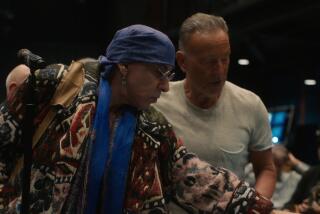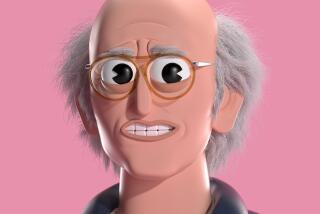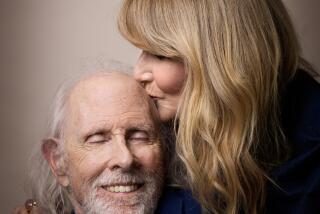Remembering the Man Who Set the Stage for Today’s Comedians
- Share via
Yesterday marked the 30th anniversary of Lenny Bruce’s death. In the late ‘50s and early ‘60s, while most stand-up comics were reciting jokes on such subjects as mothers-in-law, Bruce was exploring the satirical implications of nuclear testing, racism, illegal drugs, homophobia, back-alley abortions and the death penalty. He wanted only to talk on stage with the same freedom he exercised in his living room. But he ended up visiting FBI headquarters in San Francisco to complain that there was a conspiracy between the courts of New York and California to violate his rights.
Lenny’s fear was not exactly unjustified. “He was prosecuted because of his words,” said a former assistant district attorney. “He didn’t harm anybody; he didn’t commit an assault; he didn’t steal; he didn’t engage in any conduct which directly harmed someone else. So, therefore, he was punished, first and foremost, because of the words he used. . . . We drove him into poverty and used the law to kill him.”
When I first interviewed Lenny in 1959, he said that the role of a comedian was to get a laugh every 15 to 25 seconds. “The comedian I’m discussing now is not Christ’s jester, Timothy,” he said. “This comedian gets paid, so his first loyalty is to the club owner, and he must make money for the owner. If he can upgrade the moral standards of his community and still get laughs, he is a fine craftsman.”
A few years later, he could become so serious about what he was discussing that he would go minutes without getting a laugh. “I’m changing,” he told me. “I’m not a comedian. I’m Lenny Bruce.” He realized he was now a symbol, as well as a performer. I became the editor of his autobiography, “How to Talk Dirty and Influence People.”
At first, Bruce was paranoid about my role. “You’re gonna go to literary cocktail parties, and you’re gonna say, ‘Yeah, I found Lenny slobbering in an alley, he would’ve been nothin’ without me.”’ I denied any such intention, but he demanded that I take a lie-detector test, and I was paranoid enough to take him literally. I told him I couldn’t work with him if he didn’t trust me. We reconciled a few months later, in December 1962. He was performing at the Gate of Horn in Chicago. When I walked in, he was asking the entire audience to take a lie-detector test. He went on to discuss girlie magazines and religious hypocrisy.
Lenny was arrested that night, ostensibly for obscenity. The head of the vice squad later warned the Gate of Horn’s manager: “If this man ever uses a four-letter word in this club again, I’m going to pinch you and everyone in here. If he ever speaks against religion, I’m going to pinch you and everyone in here. Do you understand? . . . He mocks the pope--and I’m speaking as a Catholic--I’m here to tell you your license is in danger.”
Chicago had the largest membership in the Roman Catholic Church of any archdiocese in the country. Lenny’s jury consisted entirely of Catholics. The judge, the prosecutor and his assistant were Catholic. On Ash Wednesday, the judge removed the spot of ash from his forehead and told the bailiff to instruct the others to follow his lead. The reality of a judge, two prosecutors and 12 jurors, every one with a spot of ash on their foreheads, had all the surrealistic flavor of a Lenny Bruce fantasy.
Lenny was arrested 15 times within two years. “There seems to be a pattern,” he said, “that I’m a mad dog and they have to get me no matter what--the end justifies the means.” It was news in Variety that Lenny didn’t get arrested one night.
While the Chicago guilty verdict was on appeal, Lenny worked at the Off Broadway in San Francisco. Since Lenny always talked about his environment, and since police wagons and courtrooms had become his environment, the contents of his performances revolved more and more around the inequalities of the legal system. “In the halls of justice,” he declared, “the only justice is in the halls.”
When I first met Lenny, he carried an unabridged dictionary in his suitcase. Now, he carried law books. His hotel rooms were always cluttered with tapes, transcripts, photostats, law journals, legal briefs. With club owners increasingly wary of hiring him, Lenny devoted more and more time to the law. When he finally got a booking in Monterey, he said, “I feel like it’s taking me away from my work.”
Indeed, it was his own legal research that provided a foundation for his defense in his New York City obscenity trial. His most relevant argument concerned the statute he was accused of violating. Having obtained the legislative history of the statute from Albany, he discovered that, in 1931, the law was amended to exclude indecent performances by actors, among others. Hence, the law had been misapplied to him. His argument didn’t prevail.
Before sentencing, Dist. Atty. Richard Kuh recommended that no mercy be granted, because Lenny had shown a “lack of remorse.” Lenny responded: “I’m not here for remorse, but for justice. The issue is not obscenity, but that I spit in the face of authority.” The face of authority spat back, and Lenny was sentenced to four months in the workhouse. Four years after Lenny’s death, the New York Court of Appeals upheld a lower court’s reversal of his guilty verdict.
A few months before he died, Lenny wrote to me: “I’m still working on the bust of the government of New York state.” He sent his doodle of Jesus Christ nailed to the cross, with a speech balloon asking, “Where the hell is the ACLU?” Lenny had progressed from identifying with Christ’s jester to identifying with Christ himself.
Actually, Lenny Bruce served as a pioneer of free comedic speech, opening doors for the current plethora of young performers whose abuse of that freedom would undoubtedly offend Lenny. But he would be the first to say, that’s the risk of the 1st Amendment.
More to Read
The biggest entertainment stories
Get our big stories about Hollywood, film, television, music, arts, culture and more right in your inbox as soon as they publish.
You may occasionally receive promotional content from the Los Angeles Times.










